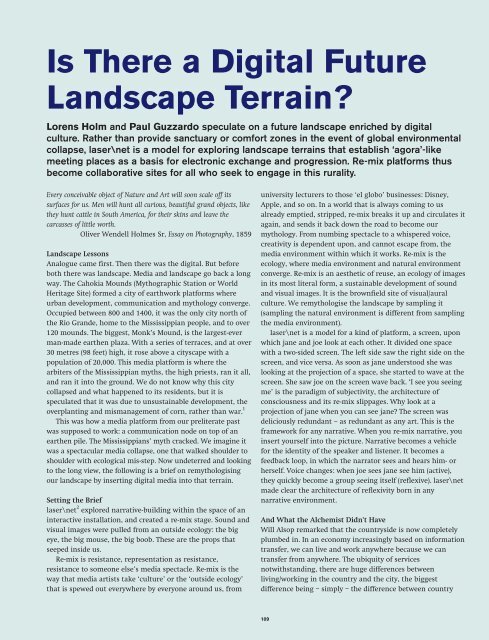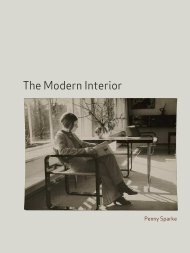Landscape Architecture: Landscape Architecture: - School of ...
Landscape Architecture: Landscape Architecture: - School of ...
Landscape Architecture: Landscape Architecture: - School of ...
- No tags were found...
Create successful ePaper yourself
Turn your PDF publications into a flip-book with our unique Google optimized e-Paper software.
Is There a Digital Future<br />
<strong>Landscape</strong> Terrain?<br />
Lorens Holm and Paul Guzzardo speculate on a future landscape enriched by digital<br />
culture. Rather than provide sanctuary or comfort zones in the event <strong>of</strong> global environmental<br />
collapse, laser\net is a model for exploring landscape terrains that establish ‘agora’-like<br />
meeting places as a basis for electronic exchange and progression. Re-mix platforms thus<br />
become collaborative sites for all who seek to engage in this rurality.<br />
Every conceivable object <strong>of</strong> Nature and Art will soon scale <strong>of</strong>f its<br />
surfaces for us. Men will hunt all curious, beautiful grand objects, like<br />
they hunt cattle in South America, for their skins and leave the<br />
carcasses <strong>of</strong> little worth.<br />
Oliver Wendell Holmes Sr, Essay on Photography, 1859<br />
<strong>Landscape</strong> Lessons<br />
Analogue came first. Then there was the digital. But before<br />
both there was landscape. Media and landscape go back a long<br />
way. The Cahokia Mounds (Mythographic Station or World<br />
Heritage Site) formed a city <strong>of</strong> earthwork platforms where<br />
urban development, communication and mythology converge.<br />
Occupied between 800 and 1400, it was the only city north <strong>of</strong><br />
the Rio Grande, home to the Mississippian people, and to over<br />
120 mounds. The biggest, Monk’s Mound, is the largest-ever<br />
man-made earthen plaza. With a series <strong>of</strong> terraces, and at over<br />
30 metres (98 feet) high, it rose above a cityscape with a<br />
population <strong>of</strong> 20,000. This media platform is where the<br />
arbiters <strong>of</strong> the Mississippian myths, the high priests, ran it all,<br />
and ran it into the ground. We do not know why this city<br />
collapsed and what happened to its residents, but it is<br />
speculated that it was due to unsustainable development, the<br />
overplanting and mismanagement <strong>of</strong> corn, rather than war. 1<br />
This was how a media platform from our preliterate past<br />
was supposed to work: a communication node on top <strong>of</strong> an<br />
earthen pile. The Mississippians’ myth cracked. We imagine it<br />
was a spectacular media collapse, one that walked shoulder to<br />
shoulder with ecological mis-step. Now undeterred and looking<br />
to the long view, the following is a brief on remythologising<br />
our landscape by inserting digital media into that terrain.<br />
Setting the Brief<br />
laser\net 2 explored narrative-building within the space <strong>of</strong> an<br />
interactive installation, and created a re-mix stage. Sound and<br />
visual images were pulled from an outside ecology: the big<br />
eye, the big mouse, the big boob. These are the props that<br />
seeped inside us.<br />
Re-mix is resistance, representation as resistance,<br />
resistance to someone else’s media spectacle. Re-mix is the<br />
way that media artists take ‘culture’ or the ‘outside ecology’<br />
that is spewed out everywhere by everyone around us, from<br />
university lecturers to those ‘el globo’ businesses: Disney,<br />
Apple, and so on. In a world that is always coming to us<br />
already emptied, stripped, re-mix breaks it up and circulates it<br />
again, and sends it back down the road to become our<br />
mythology. From numbing spectacle to a whispered voice,<br />
creativity is dependent upon, and cannot escape from, the<br />
media environment within which it works. Re-mix is the<br />
ecology, where media environment and natural environment<br />
converge. Re-mix is an aesthetic <strong>of</strong> reuse, an ecology <strong>of</strong> images<br />
in its most literal form, a sustainable development <strong>of</strong> sound<br />
and visual images. It is the brownfield site <strong>of</strong> visual/aural<br />
culture. We remythologise the landscape by sampling it<br />
(sampling the natural environment is different from sampling<br />
the media environment).<br />
laser\net is a model for a kind <strong>of</strong> platform, a screen, upon<br />
which jane and joe look at each other. It divided one space<br />
with a two-sided screen. The left side saw the right side on the<br />
screen, and vice versa. As soon as jane understood she was<br />
looking at the projection <strong>of</strong> a space, she started to wave at the<br />
screen. She saw joe on the screen wave back. ‘I see you seeing<br />
me’ is the paradigm <strong>of</strong> subjectivity, the architecture <strong>of</strong><br />
consciousness and its re-mix slippages. Why look at a<br />
projection <strong>of</strong> jane when you can see jane? The screen was<br />
deliciously redundant – as redundant as any art. This is the<br />
framework for any narrative. When you re-mix narrative, you<br />
insert yourself into the picture. Narrative becomes a vehicle<br />
for the identity <strong>of</strong> the speaker and listener. It becomes a<br />
feedback loop, in which the narrator sees and hears him- or<br />
herself. Voice changes: when joe sees jane see him (active),<br />
they quickly become a group seeing itself (reflexive). laser\net<br />
made clear the architecture <strong>of</strong> reflexivity born in any<br />
narrative environment.<br />
And What the Alchemist Didn’t Have<br />
Will Alsop remarked that the countryside is now completely<br />
plumbed in. In an economy increasingly based on information<br />
transfer, we can live and work anywhere because we can<br />
transfer from anywhere. The ubiquity <strong>of</strong> services<br />
notwithstanding, there are huge differences between<br />
living/working in the country and the city, the biggest<br />
difference being – simply – the difference between country<br />
109



